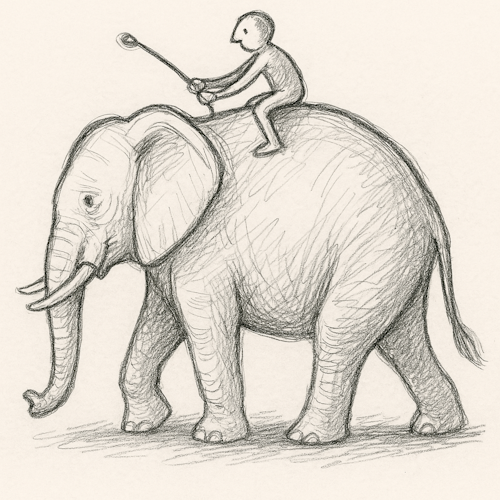The Elephant & The Rider
Illustrates Cognitive Dissonance, Change Management, Coaching, Motivation
In Agile change work, one of the biggest misconceptions is that knowledge leads to behavior change. We share charts, data, and rational arguments. But people often understand the logic and still do nothing differently. This is not a failure of intellect. It is a misunderstanding of how human decision-making works.
The Elephant and the Rider is a simple but powerful metaphor that helps explain why change is hard. Popularized by Jonathan Haidt in "The Happiness Hypothesis"1, this image illustrates the inner conflict between reason and emotion, planning and habit, control and instinct.

Imagine a small Rider sitting atop a large Elephant. The Rider holds the reins and appears to be in charge. But the Elephant is powerful. It moves when it wants to, how it wants to, and often for reasons the Rider cannot explain.
The Rider represents our rational side. It is the planner, the analyst, the part of us that sets goals and draws roadmaps.
The Elephant is our emotional and instinctive side. It is driven by fear, habit, and comfort. It wants what feels safe and familiar.
As long as both agree on the destination, the journey is smooth. But when the Elephant wants something different, the Rider cannot force it. The Rider may try to pull harder or argue with logic, but the Elephant will eventually win.
Lessons Learned
Change is Emotional, Not Just Logical
In Agile transitions, it is easy to focus on teaching frameworks and best practices. But teams are not machines. Change often requires people to rethink their identity, power, or value. These are emotional issues. The Elephant must be ready to move.
Motivation is Not The Same as Understanding
People can understand the benefits of Agile and still resist it. This is not a failure of intellect. It is a signal that something deeper is happening. Perhaps there is fear of losing control, fear of being exposed, or fear of failure. These fears sit with the Elephant.
Habits Win When Pressure Rises
Teams often commit to change during retrospectives but fall back into old patterns when stress hits. This is the Elephant pulling toward comfort. Coaches need to create space for new habits to form, especially when things get hard.
Resistance is a Signal, Not a Problem
When teams resist change, it is often because the Elephant and the Rider are not aligned. The team may agree in theory but feel unsafe in practice. Coaches should not fight resistance. They should explore what the Elephant is trying to protect.
Small Wins Matter
The best way to influence the Elephant is by shaping the environment. Clear the path. Reduce friction. Offer small successes early and often. When the Elephant feels safe and rewarded, it becomes easier to move.
Coaching Tips
- Speak to both Logic and Emotion: Use facts and stories. Address the fears behind the behavior.
- Create Psychological Safety: Teams cannot learn if they feel judged or threatened.
- Start Small: Design tiny, visible changes that build confidence.
- Be Patient: If progress stalls, look for what the Elephant is avoiding. It could be uncertainty, confusion, or fear of failure.
- Celebrate Progress: Let the Elephant feel like it is winning.
Agile change is not just a matter of installing a framework. It is about helping people behave differently under pressure. That means working with both the Rider and the Elephant.
If your team knows what to do but is not doing it, do not assume they need more training. They might need a safer path, a smaller step, or someone to walk alongside them until they are ready to move.
Good coaching helps the Rider plan, but it also understands the Elephant's fears. Change happens when both feel seen and supported.


